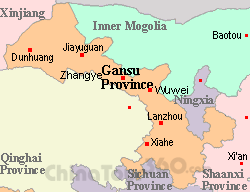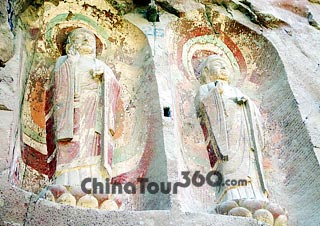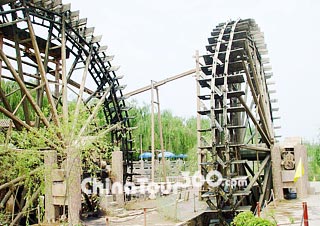![]() Facts
Facts
Phone Code: 0931
Postal Code: 730000
Area: 13,271 Sq km (5,123.9 Sq miles)
Population: 3,616,163 (in 2010)
Nationalities: There are 36 different cultural groups in total in the city, including Han, Hui, Tibetan, Dongxiang, Yugur, Bonan and Salar. Of them, ethnic minorities take up 3.6% of the total population of the city.
Neighboring Areas: Shaanxi, Sichuan, and Qinghai Provinces, Inner Mongolia, Ningxia Hui and Xinjiang Uygur Autonomous Regions
Location: It is situated on the upper reaches of the Yellow River, in the central part of Gansu Province, near China's geographic center.
![]() Physical Features: Lanzhou, a narrow stripe along the southern banks of the Yellow River, is made up of stone terraces, loess ridges and hills, and valley terraces. Surrounded by mountains in the south and north, it is higher in the northeast and lower in the southwest.
Physical Features: Lanzhou, a narrow stripe along the southern banks of the Yellow River, is made up of stone terraces, loess ridges and hills, and valley terraces. Surrounded by mountains in the south and north, it is higher in the northeast and lower in the southwest.
 |
| Lanzhou Maps |
![]() History: Occupying a strategic position on the ancient Silk Road, it was always the point of battle in ancient China. In the Western Han Dynasty (206BC - 24AD), Jincheng Prefecture was set up here to secure the area against assault. In the Sui Dynasty (581 - 618), the Jincheng Prefecture was replaced by Lanzhou State. This named has been used ever since.
History: Occupying a strategic position on the ancient Silk Road, it was always the point of battle in ancient China. In the Western Han Dynasty (206BC - 24AD), Jincheng Prefecture was set up here to secure the area against assault. In the Sui Dynasty (581 - 618), the Jincheng Prefecture was replaced by Lanzhou State. This named has been used ever since.
![]() Recommended Lanzhou Tour Itinerary:
Recommended Lanzhou Tour Itinerary:
China Silk Road Tour: 20 Days of Beijing - Xian - Xining - Lanzhou - Xiahe - Lanzhou - Wuwei - Zhangye - Jiayuguan - Dunhuang - Turpan - Urumqi – Shanghai
![]() Attractions: It is the only city in China where the Yellow River flows through and adds beauty to the city. On the Binhe Road, a charming green corridor, scenic spots line the Yellow River, including the First Bridge over the Yellow River, White Pagoda Park and Waterwheel Garden. There are a number of sculptures here including Sculpture of the Mother Yellow River, the ancient Silk Road and Journey to the West. Visitors often enjoy floating down the river on a rubber rafts. After dark, visitors can climb Lanshan Mountain for a bird eye view of the whole city.
Attractions: It is the only city in China where the Yellow River flows through and adds beauty to the city. On the Binhe Road, a charming green corridor, scenic spots line the Yellow River, including the First Bridge over the Yellow River, White Pagoda Park and Waterwheel Garden. There are a number of sculptures here including Sculpture of the Mother Yellow River, the ancient Silk Road and Journey to the West. Visitors often enjoy floating down the river on a rubber rafts. After dark, visitors can climb Lanshan Mountain for a bird eye view of the whole city.
In ancient times, the city was an important business hub, famed as 'A Bright Pearl on the Silk Road'. Deep accumulation of historical human culture during the long history left numerous historical and cultural sites, including Bingling Temple, Maiji Caves and Gansu Provincial Museum.
![]() Transportation: It is a major transport hub for railways, highways and air routes in northwest China.
Transportation: It is a major transport hub for railways, highways and air routes in northwest China.
![]() Air: Lanzhou Zhongchuan Airport has about 40 air routes to large and medium-sized cities in China such as Beijing, Shanghai, Guangzhou, Chengdu and Hong Kong.
Air: Lanzhou Zhongchuan Airport has about 40 air routes to large and medium-sized cities in China such as Beijing, Shanghai, Guangzhou, Chengdu and Hong Kong.
![]() Train: Approximately, 60 trains pass through Lanzhou Railway Station, connecting it to other Chinese cities. There are direct connections to most of the other big cities in China.
Train: Approximately, 60 trains pass through Lanzhou Railway Station, connecting it to other Chinese cities. There are direct connections to most of the other big cities in China.
- Lanzhou - Xian
- Xian - Lanzhou
- Zhangye - Lanzhou
- Lanzhou - Zhangye
- Beijing - Lanzhou
- Lanzhou - Beijing
- Tianshui - Lanzhou
- Lanzhou - Jiayuguan
- Dunhuang - Lanzhou
- Lanzhou - Lhasa
- Lanzhou - Xining
- Lanzhou - Dunhuang
- Lanzhou - Tianshui
- Jiayuguan - Lanzhou
- Xining - Lanzhou
- Lanzhou - Urumqi
- Urumqi - Lanzhou
- Lanzhou - Luoyang
- Lanzhou - Turpan
![]() Subway: Three subwya lines are under construction.
Subway: Three subwya lines are under construction.
![]() Bus: There are three main long-distance bus stations in the city: Lanzhou East, West and South Bus Stations. Buses from the east station mainly run to nearby places like Baiyin and Tianshui. Buses from the west station mostly run to Hexi Corridor (a narrow passage stretching from the steep Wushaolin hillside near the modern city of Lanzhou to the border of Gansu and Xinjiang.)
Bus: There are three main long-distance bus stations in the city: Lanzhou East, West and South Bus Stations. Buses from the east station mainly run to nearby places like Baiyin and Tianshui. Buses from the west station mostly run to Hexi Corridor (a narrow passage stretching from the steep Wushaolin hillside near the modern city of Lanzhou to the border of Gansu and Xinjiang.)
The City bus system in the city is well developed. There are direct buses to the main scenic spots in the city, with a ticket fare of CNY1 or CNY2.
![]() Taxi: The minimum fare of the taxis is CNY7 and CNY1.4 per km more after 3 km (1.9 miles).
Taxi: The minimum fare of the taxis is CNY7 and CNY1.4 per km more after 3 km (1.9 miles).
![]() Weather: The city is dry for most of the year, with short spring and summer seasons and long autumn and winter seasons. The ideal traveling time is late spring and early summer. If you want to take part in the annual Lanzhou Silk Road Festival in August or September, remember to take warm clothes.
Weather: The city is dry for most of the year, with short spring and summer seasons and long autumn and winter seasons. The ideal traveling time is late spring and early summer. If you want to take part in the annual Lanzhou Silk Road Festival in August or September, remember to take warm clothes.
![]() Dining and Shopping
Dining and Shopping
Restaurants in the city feature Sichuan, Shanghai, Guangdong and Hunan cuisines. Along with the assimilation of the other cuisines and ethnic flavors, the local people create their own flavor – Lanzhou Cuisine features various types of noodles. Lanzhou Beef Noodles is well-known all over the world. The four most famous restaurants in the city are: Jingyang Building, Yuebin Building, Emei Sichuan Dishes Restaurant and Hui Dishes Restaurant. As an area inhabited by multiple nationalities, there are also many ethnic snacks which can be found at cafes on Hezheng Road, Nongmin Lane and Jianlan Road.
The city has both business centers like Tielu Xincun, Nanguan-Xiguan and Central Square, and dispersed shopping malls and brand name shops. The new Lanzhou Ruide Mo'er City Shopping Plaza has 8 shopping malls, 2 pedestrian streets and 4 landscaped facilities, including world-renowned supermarket chains, home furniture, digital products and household electrical appliances stores.










